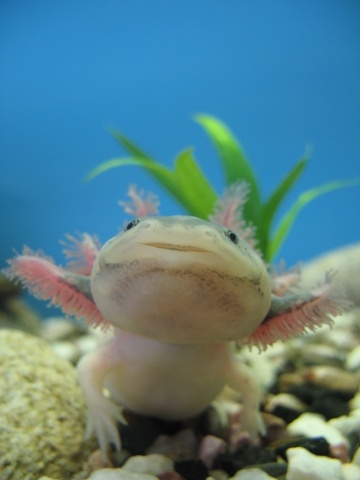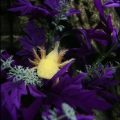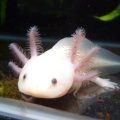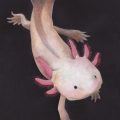Axolotl are popular display animals, well liked for their tame nature and minimal care requirements. These large, water-dwelling salamanders are usually purchased from private breeders, usually via the internet.
Axolotl’s needs, especially their temperature requirement, are very different from other reptiles, so you would have a very hard time finding a healthy specimen at a reptile shop or show. This article will provide you with the basics in axolotl care that will help prepare you to safely house one or more of these animals in a way that will keep them healthy and happy.
Size and lifespan: On average, an axolotl should live to be to the age of 10, but have been known to reach up to the low 2os if cared for properly. They will also reach an average of 10 inches from the tip of the nose to the end of their tail, with them growing past 12 in very rare. They should reach 8 inches in about a year of life, at which time they will have reached sexual maturity.
Axolotl are not social creatures, and don’t need “tank mates” to live a happy life. They’re liable to eat any fish smaller than they are that live in the same tank, and might even nip off any other axolotl’s limbs or gills if they’re held together while very young. Keeping multiple axolotl together shouldn’t be attempted without ample space or before they reach 8 cm (3 inches) in length.
Tank requirements: An axolotl will never leave the water, so its in your best interest to fill your tank up completely without adding any sort of “land area” like you would for most other amphibians. Based on their size, a 10-gallon aquarium could work for a matured axolotl, but because they are a high waste producing animal, many owners find that a 20-gallon aquarium is a lot easier to manage. You can fill your tank to the depth of your liking, but keeping a good water perimeter is a lot easier when the aquarium is filled completely. Any tank housing one or more axolotl should be fitted with a lid to prevent them from jumping out of the tank and injuring themselves.
Unlike most aquarium fish, axolotl don’t tolerate a distinct water flow, and will suffer such physical symptoms as a result such as forward-curling gills and lack of appetite. For this reason, you should be sure any water outlet of the tank holding you axolotl is fitted with a flow-spreading outlet, such as a spray bar.
A substrate is not required for an axolotl tank, but can help to maintain stable water parameters by providing plenty of surface area for needed bacteria. Aquarium safe-sand or any large pebbles are good for preventing your axolotl for eating its substrate.
Lighting and temperature: Axolotl don’t require lighting of any kind like most amphibians. They will usually become accustomed to any lighting of its habitat, but can be shy at first if there are no shaded areas available to it. A plant-friendly bulb should be chosen, and any bulbs or lighting fixtures that generate too much excess heat won’t be ideal, as axolotl overheat easily.
The low to mid 6os is the ideal temperature range for axolotl, and anything above 74 degrees will lead to loss of appetite and eventually death. Aquarium chillers are available to those who can’t provide a low enough temperature to their axolotl during the hotter parts of the year.
Food: As with most pets, live food should be avoided to keep from any parasite or disease transmission, which axolotl are very susceptible to. Fatty foods like pinkie mice should be avoided as well, with better treat food options being lean chunks of chicken or beef, or cooked frozen shrimp purchased from your local supermarket.
Night crawlers make an excellent staple food for axolotl. With no need of any sort of mineral or vitamin supplementation, they can often be fed a diet of strictly night crawlers without developing any sort of vitamin or mineral deficiency.






 Author and long-time animal lover. Sharing knowledge on pet care through experience and the written word.
Author and long-time animal lover. Sharing knowledge on pet care through experience and the written word.